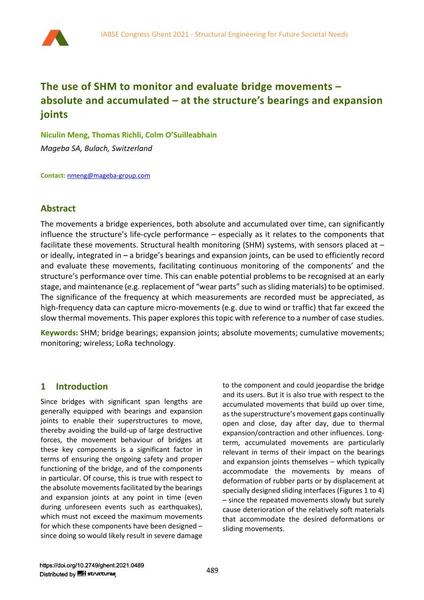The use of SHM to monitor and evaluate bridge movements – absolute and accumulated – at the structure’s bearings and expansion joints

|
|
|||||||||||
Bibliographic Details
| Author(s): |
Niculin Meng
(Mageba SA, Bulach, Switzerland)
Thomas Richli (Mageba SA, Bulach, Switzerland) Colm O’Suilleabhain (Mageba SA, Bulach, Switzerland) |
||||
|---|---|---|---|---|---|
| Medium: | conference paper | ||||
| Language(s): | English | ||||
| Conference: | IABSE Congress: Structural Engineering for Future Societal Needs, Ghent, Belgium, 22-24 September 2021 | ||||
| Published in: | IABSE Congress Ghent 2021 | ||||
|
|||||
| Page(s): | 489-496 | ||||
| Total no. of pages: | 8 | ||||
| DOI: | 10.2749/ghent.2021.0489 | ||||
| Abstract: |
The movements a bridge experiences, both absolute and accumulated over time, can significantly influence the structure’s life-cycle performance – especially as it relates to the components that facilitate these movements. Structural health monitoring (SHM) systems, with sensors placed at – or ideally, integrated in – a bridge’s bearings and expansion joints, can be used to efficiently record and evaluate these movements, facilitating continuous monitoring of the components’ and the structure’s performance over time. This can enable potential problems to be recognised at an early stage, and maintenance (e.g. replacement of “wear parts” such as sliding materials) to be optimised. The significance of the frequency at which measurements are recorded must be appreciated, as high-frequency data can capture micro-movements (e.g. due to wind or traffic) that far exceed the slow thermal movements. This paper explores this topic with reference to a number of case studies. |
||||
| Keywords: |
bridge bearings monitoring expansion joints SHM cumulative movements wireless absolute movements LoRa technology
|
||||
| Copyright: | © 2021 International Association for Bridge and Structural Engineering (IABSE) | ||||
| License: | This creative work is copyrighted material and may not be used without explicit approval by the author and/or copyright owner. |
||||
